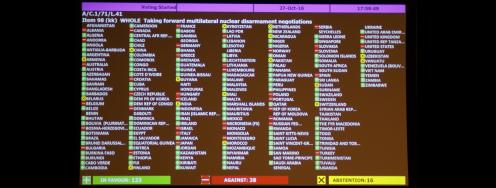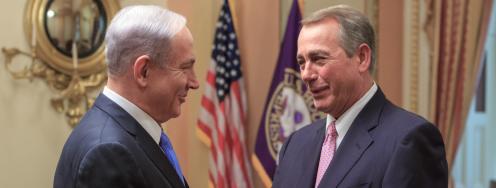Potential for Breakthrough: U.S. and Iran Moving Toward Direct Talks
On the radar: Letters, sidelines, and one-on-ones; One expensive boat; Putin in the Gray Lady; Syria spotlight; White steam at Yongbyon; and Kennedy’s bellicose bureaucracy.
On the radar: Letters, sidelines, and one-on-ones; One expensive boat; Putin in the Gray Lady; Syria spotlight; White steam at Yongbyon; and Kennedy’s bellicose bureaucracy.
September 12, 2013 | Edited by Benjamin Loehrke and Alyssa Demus
Talks moving - “Signaling a possible thaw in long-frozen relations, the Obama administration and the new leadership in Iran are communicating about Syria and are moving behind the scenes toward direct talks that both governments hope can ease the escalating confrontation over Tehran's nuclear program,” writes Paul Richter for The LA Times.
--President Obama and Iranian President Hassan Rouhani reportedly exchanged letters. Officials say it’s possible the two could meet on the sidelines of the UN General Assembly on September 24, as U.S. and Iranian officials lay the groundwork for potential one-on-one talks between the two governments.
--Rouhani's election "presents an opportunity for Iran to act quickly to resolve the international community's deep concerns over Iran's nuclear program...Should this new government choose to engage substantially and seriously to meet its international obligations and find a peaceful solution to this issue, it will find a willing partner in the United States," said National Security Council spokeswoman Bernadette Meehan. Full story here. http://lat.ms/17SkL54
Welcome to Early Warning - Subscribe to our morning email or follow us on twitter.
--Have a tip or feedback for the editor? Email earlywarning@ploughshares.org earlywarning@ploughshares.org. Want to support this work? Click here.
Changing tone - "Based on its rights and obligations recognized under the NPT (Non-Proliferation Treaty), Iran is ready to faithfully engage and remove any ambiguity on its nuclear activities," said Iranian Ambassador to the IAEA Reza Najafi at an IAEA board meeting on Thursday.
--Western diplomats attending the IAEA board meeting said “Najafi's remarks - though short on specifics - were more matter of fact than those of his predecessor, Ali Asghar Soltanieh, who often used IAEA board meetings to rail against Tehran's Western foes and the U.N. nuclear agency,” reports Fredrik Dahl at Reuters. http://ow.ly/oOl06
Breaking new ground - “On Iran, we may be coming to that moment, where those entrusted by the president to break open new opportunities will have to step out of their comfort zones to help the president achieve his goal of an Iran without a nuclear weapon,” writes Joel Rubin in The Huffington Post. Full article: “Iran Diplomacy Through the Prism of the Syria Debate” http://huff.to/15UrkGk
Big ticket item - Each of the 14 new Ohio replacement ballistic missile submarines is expected to cost about $6 billion on average. That is an expensive, especially when compared to the Navy’s total annual shipbuilding budget of $14 billion. “The Ohio class replacement is an enormously big ticket item,” said Rep. Randy Forbes (R-VA) in a preview of a House Armed Services hearing today on Navy submarine projects.
--How do the program’s advocates propose finding funding for the boomers? “I have advocated very strongly for not taking [Ohio replacement sub funds] out of the Navy shipbuilding budget and looking at that as a strategic asset that should come out of DoD as an additional line item,” said Rep. Forbes. This raised the question, “But how does Forbes plan to convince the other parts of the Pentagon, or for that matter the other subcommittees of the HASC, to give up budget share to save the Navy? They certainly won’t go quietly,” writes Sydney Freedberg, Jr. at Breaking Defense. http://bit.ly/15UiIzn
Required, supposing unchanging requirements - Rear Admiral Richard Breckenridge, the Navy’s Director of Undersea Warfare, will testify on the Hill today, urging Congress to support the Navy’s current plans buy 12 new Ohio replacement ballistic missile submarines.
--From the written statement: “It is mandatory that we sustain our survivable sea-based nuclear deterrent with about the same level of at-sea presence as today – this is priority number one,” said Adm. Breckenridge. “We are acutely mindful of the costs of the OHIO Replacement Program, and the burden these costs pose on the Navy’s entire shipbuilding program, and the resultant impact on nation’s shipbuilding industrial base. We are absolutely determined to work across the Navy, with industry, and with Congress to field the OHIO Replacement in the most affordable manner consistent with mission requirements.” Full testimony here. (pdf) http://1.usa.gov/15Zm4KO
Transmission from Vladimir - Russian President Vladimir Putin penned an op-ed in The New York Times that urges U.S. caution on Syria and generally trolls about the United States’ history of circumventing the UN Security Council.
--On the topic of the day: ”A new opportunity to avoid military action has emerged in the past few days. The United States, Russia and all members of the international community must take advantage of the Syrian government’s willingness to place its chemical arsenal under international control for subsequent destruction. Judging by the statements of President Obama, the United States sees this as an alternative to military action. I welcome the president’s interest in continuing the dialogue with Russia on Syria,” wrote Putin. Full article here. http://nyti.ms/15WGbKo
Syria roundup:
--”How to secure Syria's chemical weapons” by Daryl Kimball and Paul Walker in The Christian Science Monitor. http://bit.ly/1aEYF9X
--”The US with Iran in Syria” by Seyed Hossein Mousavian for Project Syndicate. http://bit.ly/15ZripO
--”What to do now? Iran Torn on Syria” by Alireza Nader for The Iran Primer. http://bit.ly/14IZoUZ
Tweet - @Cirincione: I talked with @MarthaRaddatz about Syria last night @ABCWorldNews: Behind Diplomatic Possibilities w/ Syria & Russia http://t.co/JEEM3IbbDl
Tweet - @TheLugarCenter: Lugar proposed US and Russia team up to rid chemical weapons 1 year ago. #LugaronSyria #Syria http://nyti.ms/17ZeYIT
Yongbyon restart - “New commercial satellite imagery of North Korea’s Yongbyon nuclear facility indicates that Pyongyang is probably restarting its 5 MWe gas-graphite plutonium production reactor. Since announcing in early April 2013 its intention to restart this reactor, work has progressed rapidly over the spring and summer to bring the facility back into operation,” according to analysts Nick Hansen and Jeffrey Lewis.
--Why it matters: “The 5 MWe reactor is capable of producing six kilograms of plutonium a year that can be used by Pyongyang to slowly increase the size of its nuclear weapons stockpile.” Full analysis at 38 North. http://bit.ly/14OAI8a
Events:
--”Unthinkable: Iran, the Bomb, and American Strategy” Discussion with author Kenneth Pollack on his new book, with Tamara Cofman Wittes and Robin Wright. September 16 from 2:30-4:00pm at Brookings. http://bit.ly/18Xath8
--Javad Zarif, Iranian Foreign Minister and Catherine Ashton, EU foreign policy chief resume talks on Iran’s nuclear program. Week of September 23. United Nations.
Dessert:
History lesson - “President Kennedy faced a foe more relentless than Khrushchev, just across the Potomac: the bellicose Joint Chiefs of Staff argued for the deployment of nuclear weapons and kept pressing to invade Cuba. A presidential historian reveals that Kennedy's success in fending them off may have been his most consequential victory,” writes Robert Dallek in a long form article for The Atlantic.
--Timely quote: After reviewing a military plan for a nuclear attack on Cuba, Kennedy asked Robert McNamara, “What good are they? You can’t use them as a first weapon yourself. They are only good for deterring … I don’t see quite why we’re building as many as we’re building.” http://bit.ly/185HMNG



